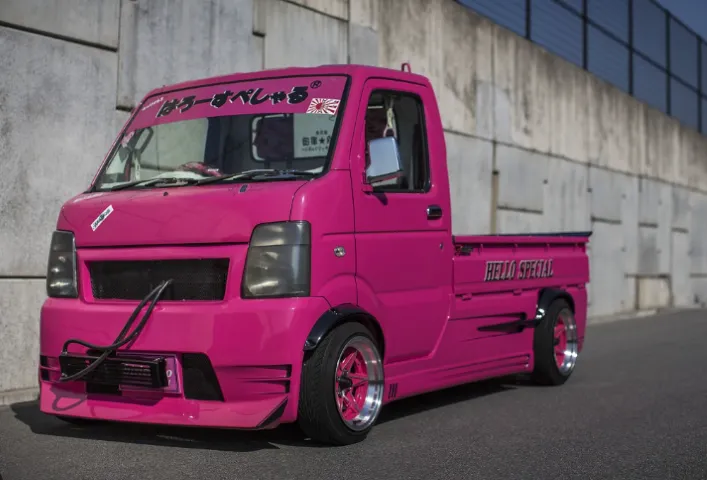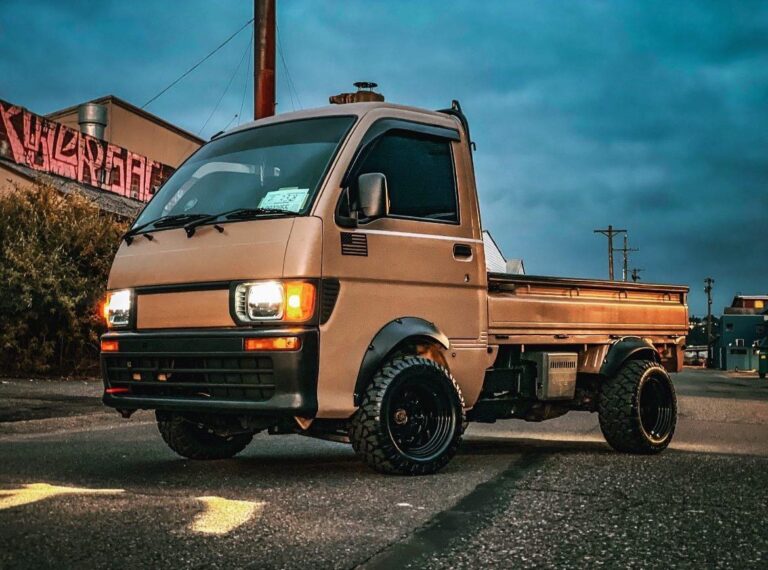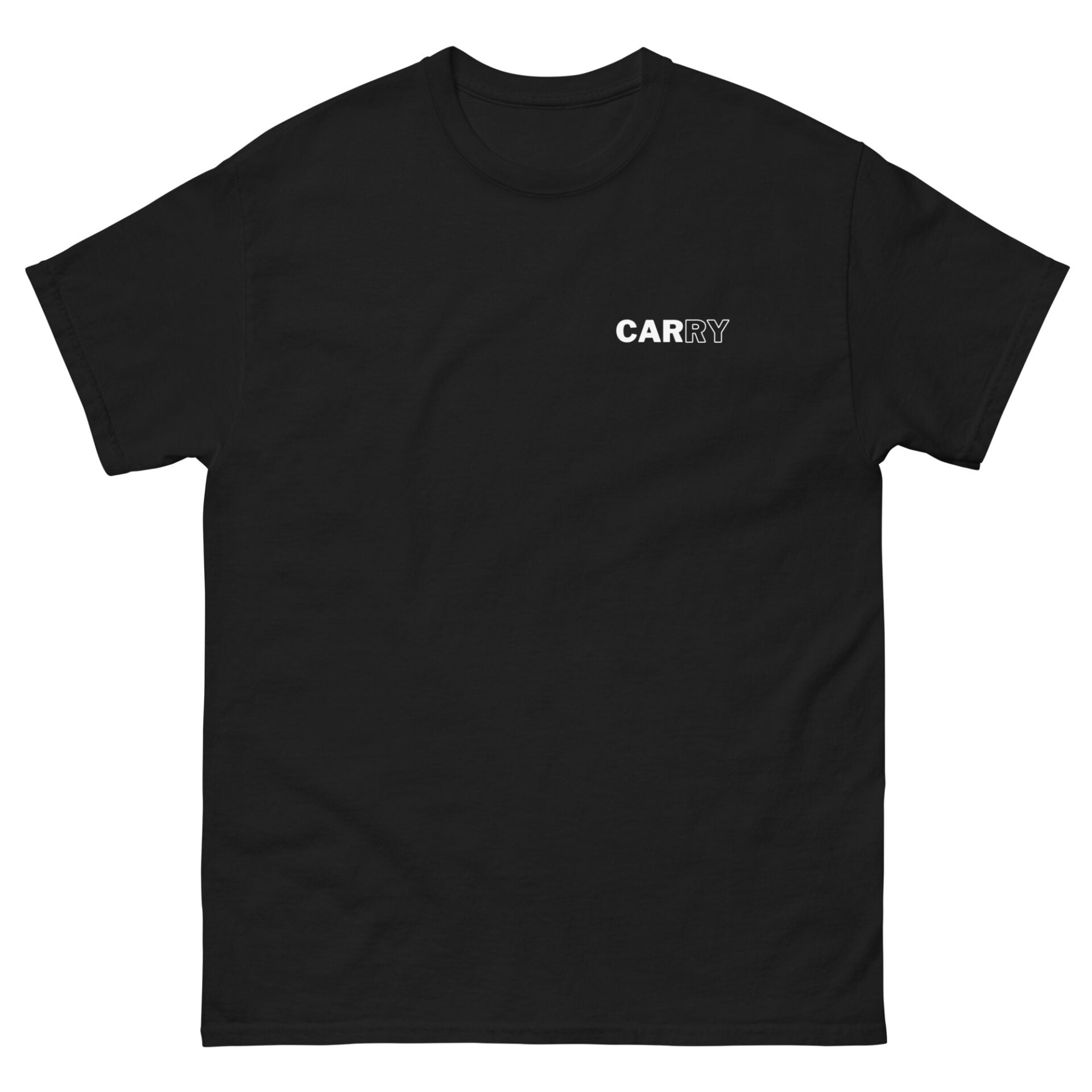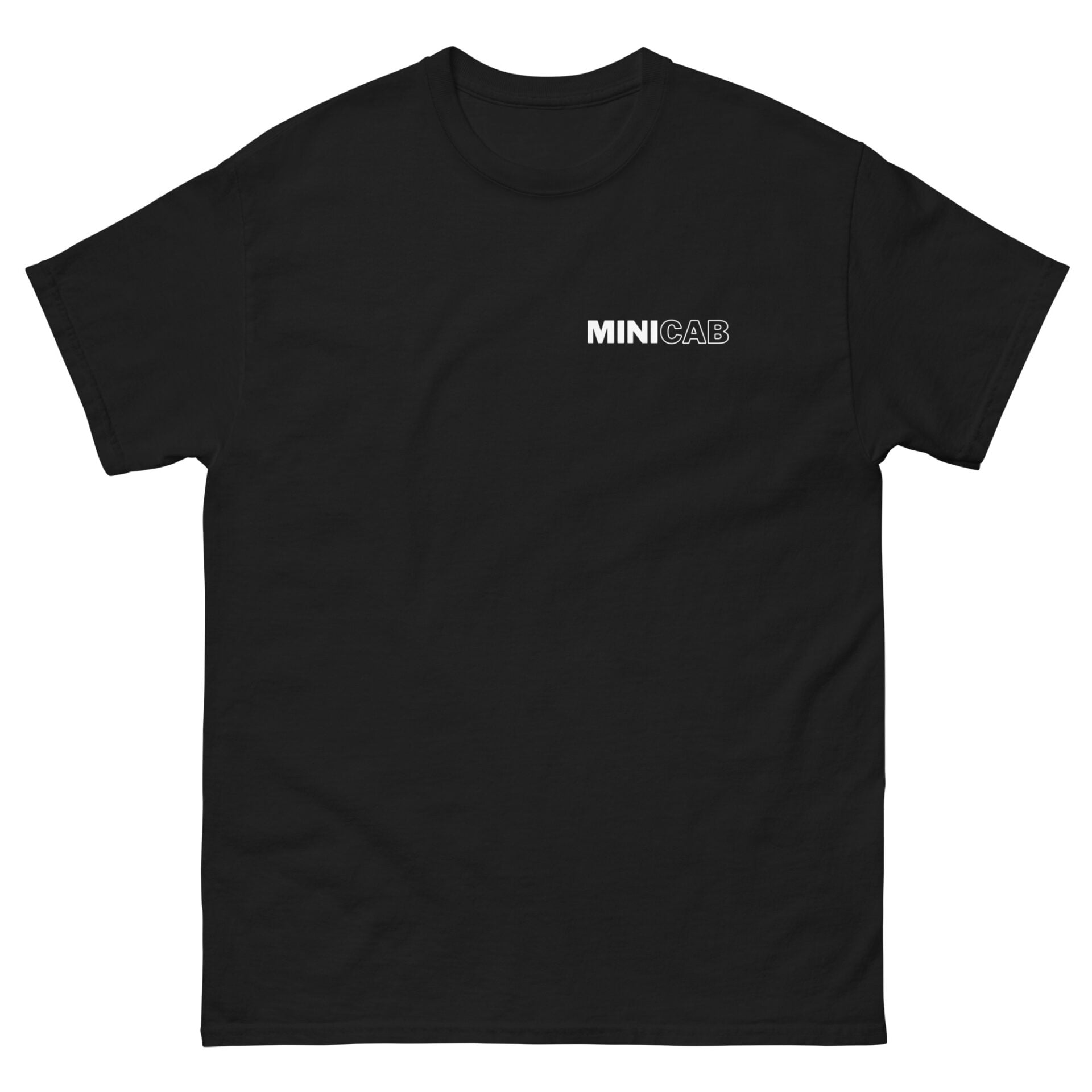Special thanks to keitrucks for the rad feature image, check out his Instagram’s page here.
Thinking about buying a light commercial vehicle but aren’t sure which one’s right for you? You might want to consider the Daihatsu Hijet. This trusted model has been a reliable choice in the market since 1960, meeting various business needs, from cargo transportation to small business operations. In this Daihatsu Hijet review, we’ll cover everything you need to know – from its history and different models, to its practicality, performance, maintenance, and safety features. By the end of this review, you’ll have a clear picture of the Hijet’s strengths and weaknesses, helping you make an informed decision. Let’s find out if the Daihatsu Hijet is the perfect fit for your business needs.
Introduction to Daihatsu Hijet
History of the Daihatsu Hijet
The Daihatsu Hijet, a kei truck/microvan, has been a mainstay in the light commercial vehicle market since 1960. The first generation Hijet had a conventional layout with the driver sitting behind the engine. But the second generation brought a cabover approach, giving buyers a choice between the two styles. Over the years, the Hijet’s seen numerous improvements and updates, like rehinging the front doors in the conventional manner in the third generation and introducing all-new sheet metal in the fourth. The fifth generation, known as the Hijet Wide 55, boasted a wider body and a larger 550 cc engine. The sixth generation introduced the Hijet 4WD and the Hijet Atrai Van, specifically designed for passenger use. The Hijet’s been exported to various countries and sold under different names, such as the Daihatsu 550 Cab and Cab-Van, and it’s been particularly popular in Southeast Asian markets.
Different Models: An Overview
The Daihatsu Hijet comes in a variety of models, each designed to cater to specific needs and preferences. These include pickup trucks, vans, and passenger vans. The Hijet series has evolved with the changing times, with the latest generation of Hijet Cargo, Atrai, and Hijet Truck mini commercial vehicles being fully redesigned after 17 years. The new models have been updated with the Daihatsu New Global Architecture (DNGA) platform, resulting in improved fuel efficiency and quiet performance. For instance, the Hijet Cargo boasts the largest loading space in its class, making it ideal for your last-mile small-lot delivery needs. The Atrai, on the other hand, maximizes the usability of its spacious and high-loading capacity luggage space to meet your leisure and other needs.

Purpose and Practicality
The Daihatsu Hijet is known for its compact size, maneuverability, and efficient performance, making it suitable for urban environments and small-scale transportation tasks. Its purpose and practicality lie in its ability to adapt to different business needs. Whether it’s cargo transportation, delivery services, or small business operations, the Hijet has proven its reliability, durability, and ease of use in various real-life testing scenarios. Its features, such as a compact size, efficient engines, comfortable interiors, and customizable cargo space, provide convenience and functionality for different use-cases. However, you should be aware of its limitations, such as limited cargo capacity and lack of advanced safety features compared to larger commercial vehicles.
Market Position in Light Commercial Vehicles
In the light commercial vehicle market, the Daihatsu Hijet holds a competitive position, going head-to-head with other popular models like the Suzuki Carry, Honda Acty, and Mitsubishi Minicab. Its fuel efficiency, affordability, ease of maintenance, and versatility make it a strong contender. The performance of the Hijet is commendable, with its small engines delivering sufficient power for urban driving and light loads. It offers good maneuverability and agility, making it suitable for navigating tight spaces. The Hijet’s market position is further strengthened by its wide range of models and configurations, catering to your needs and preferences.
Performance and Handling
Engine Performance
The Hijet’s power source varies with each generation. For instance, the eleventh generation is equipped with either a 658cc KF-VE I3 or a 658cc KF-DET I3-T gasoline engine. These power units are known for their fuel efficiency, covering between 15 to 19 kilometers per liter. Regular maintenance, including timely engine oil changes and spark plug replacements, can enhance the engine’s performance and longevity. Routine engine inspections and cleaning can help detect and rectify potential issues early, reducing the frequency of garage visits and maintenance costs.
Transmission Options
The Hijet’s transmission type and the number of gears available can influence its performance and handling. For example, it features a 4-speed manual transmission gearbox, which ensures smooth gear transitions and precise control.
Steering and Maneuverability
The Hijet’s steering system is designed to be responsive and easy to handle, facilitating smooth and precise handling. Its compact dimensions, measuring 329.5 cm in length and 139.5 cm in width, enable it to navigate narrow streets and congested areas effortlessly. The inclusion of power steering enhances its handling, particularly in urban driving conditions. It also boasts a balanced traction and stability system, making it adaptable to various road conditions.
Suspension and Brake System
The Hijet’s suspension and brake system significantly contribute to its performance and handling. A well-structured suspension system ensures a comfortable ride and improved stability, while a dependable brake system provides safe stopping power. Its mid-drive wheels and suspension system offer a comfortable and stable ride. The wheelbase, measuring 181 cm, ensures a balanced ride. The ride height provides adequate ground clearance, facilitating easy navigation of uneven terrain. The wheels, lightweight yet durable, ensure stability and reliable performance on diverse road surfaces.
Interior and Exterior Features
Cabin Design and Comfort
The Hijet’s interior is designed with a focus on practicality and comfort. The elevated front pillars provide additional headroom, contributing to a roomy feel. An overhead shelf capitalizes on the increased cabin height, providing additional storage. The seat fabric has been enhanced for longevity, and the dashboard layout has been updated for user-friendliness. However, taller drivers may find the front seating area a bit snug..
Exterior Styling and Dimensions
The Hijet’s exterior is both functional and robust. The front bumper is split into two sections, allowing for the lower part to be replaced separately, reducing repair costs. The placement of the rear corporate and vehicle emblems has been shifted to the right, providing additional space for advertising. The new vehicles are available in a palette of seven colors, including three new additions: Ice Green, Shining White Pearl, and Tonico Orange Metallic.
Cargo Space Evaluation
The Hijet Cargo’s body design maximizes its load capacity, making it a top choice for small-lot delivery and construction industry needs. The straight sides and backdoor, along with the squared body, optimize the luggage space. The rear seat belt buckles are integrated with the seats and the seat-fastening brackets are embedded into the floor, creating a flat surface for easy loading and unloading of cargo. The number of cargo space nuts, useful for securing various types of cargo, have been significantly increased from the previous model.
Fuel Efficiency and Maintenance
Fuel Economy Ratings
The Hijet’s fuel economy is noteworthy. For instance, the 1996-1998 Hijet 660 Standard model boasts a fuel consumption rate of approximately 58.8 mpg US in the 60 km/h mode. This efficiency translates into significant fuel savings and extended travel distances before refueling. With a fuel tank capacity of 10 US gallons, it’s well-suited for both urban commuting and extended journeys.
Maintenance Costs
The Hijet’s maintenance requirements are straightforward and cost-effective. Routine tasks such as oil changes, coolant checks, brake inspections, tire rotation and balancing, battery checks, and air filter cleaning or replacement are crucial to maintaining its optimal performance. Adherence to these maintenance practices ensures the Hijet’s reliability and peak performance, making it a cost-effective choice for both personal and commercial applications.
Long-term Reliability
The Hijet is renowned for its durability and reliability. It’s engineered to withstand commercial use and is built to last. Regular maintenance is not just beneficial, but essential for its longevity. By adhering to regular maintenance schedules, you can enhance its performance, fuel economy, safety, and overall lifespan.
Spare Parts Accessibility
One of the advantages of owning a Hijet is the ease of sourcing spare parts. Whether you need a filter, a belt, or a tire, Hijet parts are readily available. This ease of access not only simplifies maintenance but also contributes to its overall longevity and performance. It’s recommended to use Daihatsu mini truck parts to ensure optimal fit and performance.

Safety Features and Regulations Compliance
Standard Safety Features
The Hijet is equipped with essential safety features such as airbags and seat belts. It also incorporates an anti-lock braking system (ABS) and electronic stability control (ESC), enhancing vehicle control and reducing accident risks.
Advanced Safety Technology
In addition to the basic safety features, the newer model Hijets include advanced safety technology. This encompasses a lane departure warning system, which signals if the vehicle deviates from its lane without the turn signal being activated. It also includes a forward collision warning system, alerting you of a potential collision with a vehicle ahead. A blind spot monitoring system is also present, signaling the presence of vehicles in blind spots during lane changes or parking maneuvers. These technologies aim to prevent accidents and provide an additional safety layer for the vehicle’s occupants.
Compliance with Global Vehicle Standards
The Hijet is designed and manufactured to comply with global vehicle standards, including those set by organizations such as the United Nations Economic Commission for Europe (UNECE) and the National Highway Traffic Safety Administration (NHTSA). This compliance ensures that the vehicle meets the necessary safety requirements and regulations, providing peace of mind for potential buyers.
Wrapping Up the Daihatsu Hijet Review
From its historical innovations to its adaptable features, the Daihatsu Hijet holds its unique charm in the sea of light commercial vehicles. Its purposeful design, performance capabilities, and practicality make it a reliable choice for small businesses and urban environments. While it might lack some advanced safety features, it provides considerable value in its class with fuel efficiency, affordability, and versatility. Remember, user satisfaction is subjective, and what works for you might not work for everyone. Still, the Hijet strikes an impressive balance between functionality, simplicity, and cost-effectiveness, proving its presence on the roads for more than six decades. This kei truck/microvan certainly deserves a test drive if you’re seeking a compact and versatile vehicle for your light commercial needs.











